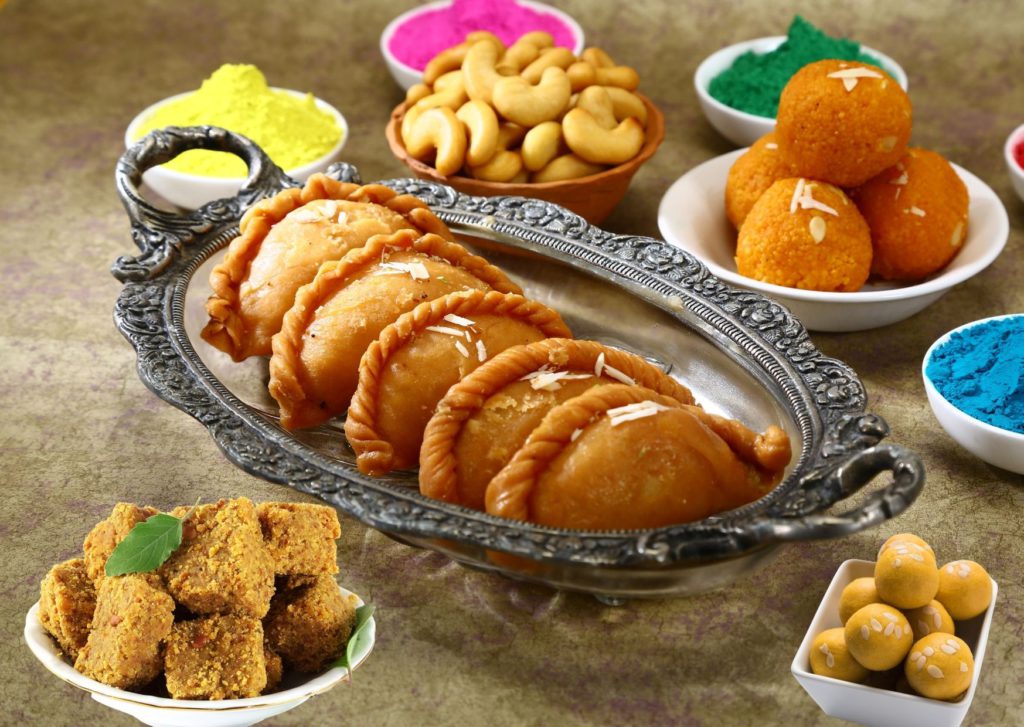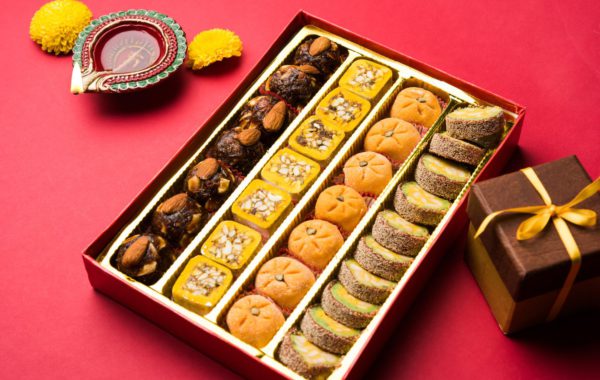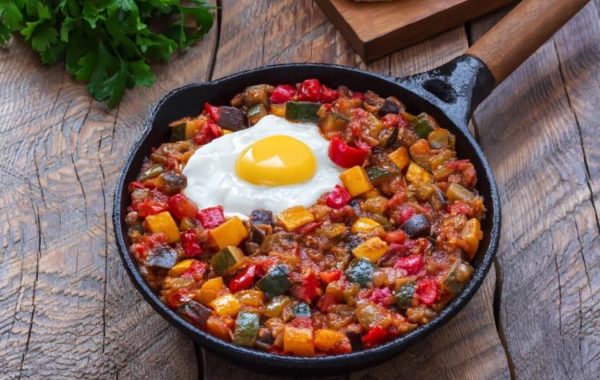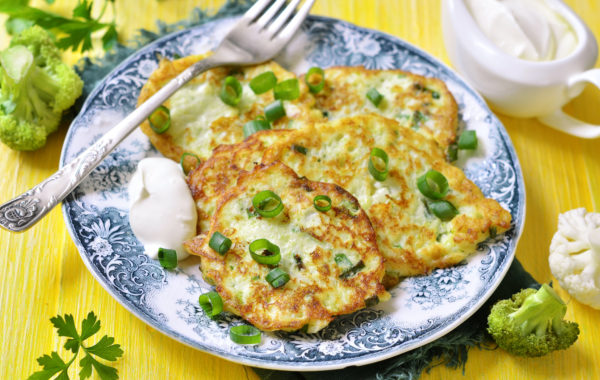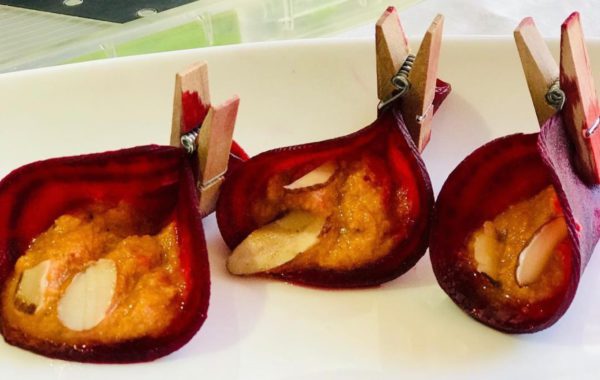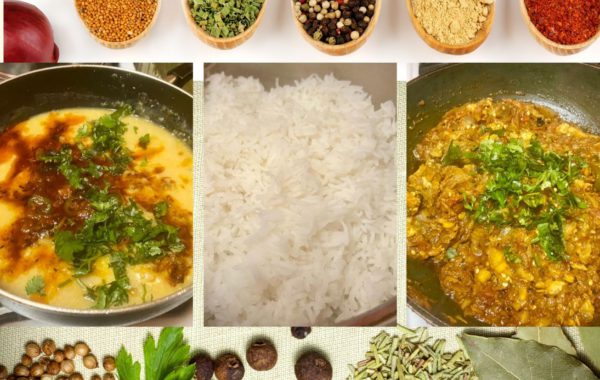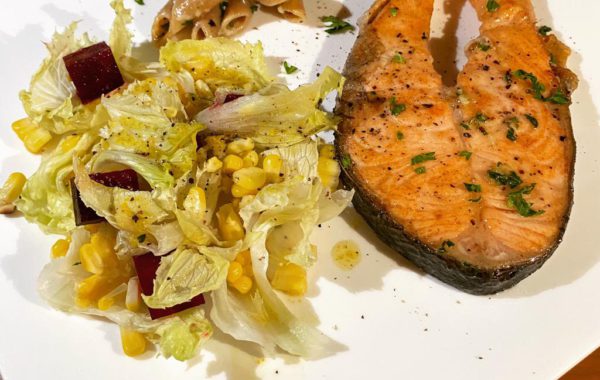Mohanthal, Magaj and Dry fruit Ghughra from the Shahs Kitchen
The Shahs have been our neighbours for about 20 years now and each year come Diwali, the most delicious, mouth-watering aromas waft into our home from theirs, and we eagerly await the “Thaali” full of Diwali goodies that invariably find their way to us on the day of “Bestu varsh” -The Gujarati new year, as we wish each other “Saal-Mubaarak”.
This year we had the privilege of securing the front seats to their Diwali cook-fest as Mrs. Hetal Shah and her Mother-in-law, the 77 year old Senior Mrs. Shah, who we call Chandrika Masi (Masi means Aunt in Gujarati), let us in to their kitchen and in on their secrets of how to make the perfect Dry Fruit Ghughra, Mohanthal and it’s easier cousin: Magaj!
Mrs. Chandrikaben Shah has been cooking since she was barely 14 years of age! She tells us how in her little village of Dhinoj, a short distance from Mehsana in Gujarat, she had no choice but to learn all the house-work and cooking, as there was way too much work for her mother to handle alone. Chandrika Masi has therefore perfected the art of cooking over a good 63 years and the traditional Gujarati dishes she makes are absolutely a treat to savour.
So here are the recipes of two of her favourite Diwali sweets:
1. Mohanthal
Ingredients:
Coarse besan (Chickpea flour) : 500gms
Mawa: 250 gms (If homemade, you can evaporate 1 litre milk in a non-stick pan on slow flame till it becomes mawa)
Sugar: 400 gms
Ghee : 300 gms
Mixed dryfuits (Almonds, cashews, Pistachios) : 1 cup, coarsely powdered
Cardamom powder: 1 teaspoon
Saffron: ½ teaspoon
Milk : ½ cup + 2 Tablespoons
Method:
To begin, mix 2 teaspoons of the ghee in the ½ cup milk. Take the Besan in a plate. Pour the mixture of ghee and milk onto the Besan and mix it well. Now run the mixture through a sieve, it rubbing it through with your hand still it resembles a coarse breadcrumb like mixture. This process is called “Dhabo” and it gives the Mohantal a lovely grainy texture. This is the 1st secret that Chandrika Masi divulges.
Next in a non-stick pan roast the Mawa, still it is Golden Brown. Ensure that the Mawa is properly roasted as this will allow the Mohanthal to keep for a week or more. We are told that the Mawa is optional. But since this Mohanthal is being made for Diwali, of course Mawa is a must!
Take 1 tablespoon warm milk in a bowl and add the kesar to it. Keep aside for now, allowing it to infuse colour and aroma into the milk.
Grease a “Thali” or tray of atleast 1” depth with ghee and keep it ready.
Take the ghee in a big Kadhai and add the Besan to it. Roast the Besan on a slow flame continuously stirring, till the aroma of the roasted Besan is released and it becomes brown in colour. Add the roasted Mawa to this before taking it off the gas and continue to roast the two together for a little while longer. Add the elaichi powder and coarsely powdered dryfruit just before taking the Besan-Mawa mixture off the heat. Set the mixture aside.
Time to make the sugar syrup now! Put the sugar in a thick bottomed vessel and pour water till just above the level of the sugar. Heat the mixture, stirring continuously till it starts bubbling. Now comes Chandrika Masi’s 2nd secret: Add 1 tablespoon of milk to the bubbling sugar syrup. This causes the impurities in the sugar to precipitate and rise to the top! Carefully remove the impurities with a spoon and discard. Now add the Saffron-infused milk to the sugar syrup and let it continue to bubble, until it becomes a “1 and half string” consistency syrup (take a look at the video to understand what this means). Chandrika Masi takes a drop of the hot syrup between her thumb and forefinger and demonstrates the formation of the string. The other indicator of the sugar syrup being ready is let a drop fall on a steel plate. Now when you tilt and turn the plate, if the syrup runs down, it is still not ready. When ready, the syrup, instead of running down the plate, will form a firmer drop and will retain its shape, demonstrates Hetal.
As soon as the syrup reaches the right consistency, little by little add the roasted Besan-Mawa-dryfruit mixture to it, stirring well all the time. (This is a two-man .. oops two-woman job, and needs strength!) Keep stirring till it thickens. Now comes the 3rd secret: How do you tell that the mixture is done? Try to get the spoon / spatula that you are stirring the mixture with to stand straight in the middle of the kadhai. When the mixture is nearly ready, the spoon will stand up steadily for several seconds. Up until then it will keep falling down! Neat trick!!
So now the Mohanthal mixtures smells heavenly and we are nearly drooling! It’s taken off the stove and Chandrika Masi and Hetal together carefully spoon it into the greased tray, patting it even while it is super-hot to flatten it.
At this point, they explain, you can decorate the hot mixture with sliced almonds, pistachio or cashew bits, but they prefer to incorporate the dry fruits into the Mohanthal itself, as the dryfruit bits sprinkled on top tend to fall off and often get wasted! Moreover, the dryfruits mixed into the Mohanthal make it all the more delicious! There you go! That’s secret number 4!
We are at this point literally waiting for the Mohanthal to cool and our kind hostesses to offer us a piece of the golden goodness, and we are not disappointed! We break off one piece and share it and it is every bit as wonderful as it has been smelling!
We are however a wee bit intimidated by the various technicalities of the recipe, so the Senior Mrs. Shah tells us not to worry. She gives us an easier version of the recipe called “Magaj”, which are basically like besan laddoos. These don’t need sugar syrup or mawa. You take about 300 gms of powdered sugar and mix it into the Besan – dryfruit mixture once its cool and make laddoos. Much easier and faster! That’s the 5th secret!
So there you are! All of Chandrika Masi’s best kept secrets revealed! Now don’t wait! Do try out this recipe right away! You will not be disappointed.
2. Dryfruit Ghughra:
These half-moon shaped crisp pastry pockets are sheer parcels of delight! All these years we have been wondering why they taste so different than those made by anyone else and finally this year we know! The secret is that the stuffing has Mawa and dry fruits mixed together!
To those who are wondering what Ghughra are: They are also called Gujia in North India. The Maharashtrian version is “Karanji” which has either fresh coconut, jaggery and cardamom powder or dry coconut powder, sugar and cardamom as the stuffing. One of our aunts even uses Gulkand (rose petal preserve) in the Karanji stuffing to make the most divine rose and pistachio Karnajis – but more about those some other time,
Anyway, coming back to the “Ghughra” – and the secrets that make the Shah household version so very scrumptious!
Ingredients:
For the stuffing:
Mawa: 300 gms or made from 1 litre milk evaporated in a non-stick pan
Mixed dry fruit (Almonds, Pistachio, Walnuts, Cashews) coarsely powdered: 250 gms
Powdered Sugar : 1 cup
Poppy seeds (Khus-khus) : 1 Tablespoon
Nutmeg: 1 whole or if large sized then ¾ th of it
Mace (Javantri): 1 teaspoon
For the outer pastry:
Maida: 500 gms
Ghee: 3 Tablespoons
Hot water to knead the dough
Ghee for frying the ghughra: about 500 ml (Can be substituted with oil, but then the Ghughra won’t taste as good!)
Method:
The outer pastry: Mix the liquified ghee into the maida. Mix together with fingertips till it resembles a breadcrumb like mixture. When held in your fist and released it should hold its shape. If it doesn’t add a bit more ghee. Now bit by bit add hot water and knead. The dough should be a slightly hard / firm one: Much firmer than that for chapatis. Cover with a damp cloth and set aside.
The stuffing: Powder the nutmeg and mace and set aside. Roast the Mawa on a slow flame till light brown. Well roasted mawa ensures that the Ghughras will keep longer. Take the roasted Mawa off the gas and while still warm break it up into crumbs with your fingertips (you can use a fork if you find the mawa too hot to handle). Once cooled, add the powdered sugar, nutmeg and mace, the poppy seeds and the mixed dry-fruit powder and mix well.
We are now ready to assemble the ghughras. Take a small bit of the dough, knead it well and roll out a thin circle about 2 ½ inch in diameter. The rolled out sheet should be almost translucent and as I watch Hetal roll it out, I can see the faint outline of her fingers through it. Now carefully spoon about 2 teaspoons full of the dryfruit – mawa mixture into one half of the circle and fold over the other half to make it into a semi-circle. Here Hetal starts sealing the edge into a pretty design. She leaves some in a half-moon shape while others she pinches together at the ends to make a cute little shape. As she puts the ghughras together, Chandrika Masi gets the ghee hot in the Kadhai and starts frying them one by one.
She fries them to a perfect golden brown colour and the pastry dough becomes crisp with a slightly bubbled surface.
We can’t wait for the Ghughra to cool down. Even before they are at room temperature, we bite into them, the perfectly crisp outer pastry gives in and the lightly sweetened filling explodes into a multitude of flavours in our mouths!
About the Shahs:
Mrs. Chandrika Shah is a home-maker and a home-cook par excellence, with over 60 years of experience in the kitchen. Mrs. Hetal Shah is an entrepreneur who specialises in exclusive handmade items. Her aesthetic sense is only matched by her culinary skills. As skilled as she is in traditional Gujarati cuisine, she loves to experiment with international cuisine, to delight her children.
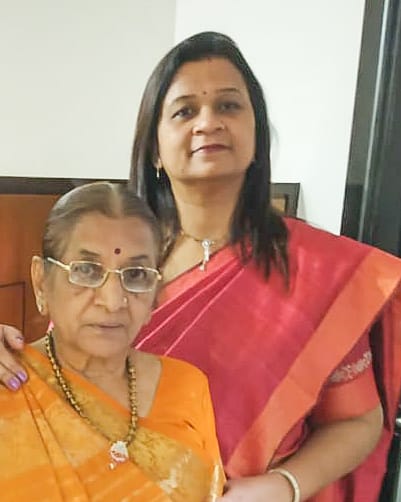
Related Diwali Coverage:
4 Recipes Of Uniquely Maharashtrian Diwali Favorites
The Indian Mithai Make-Over | Diwali Special
Festive Treat | Watch Mom Make Chivda For Diwali
Sanjay has been navigating the stormy waters of the Indian media and entertainment industry for nearly 3 decades, and has worked with some of the leading Indian and international media brands in this time. His travels to various international destinations for work and leisure has led him to appreciate the connection between food and travel, and he likes to share his experiences through his articles on Travel and Food Network. He lives in Mumbai, but considers himself a global foodie-citizen.


